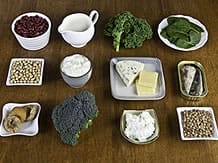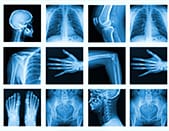…in osteoporosis?

Bone health requires a steady and sufficient intake of calcium, vitamin D and protein.
Calcium is the most abundant mineral in the body (approximately 1.2 kg in the body). 99% of the calcium in the body is found in the skeleton, giving it its strength and rigidity. The remaining calcium (1%) is involved in muscle contraction, blood clotting and the correct functioning of the nervous system. Hence, in the event of inadequate intake, bone calcium serves as a reserve to ensure optimal blood levels of calcium for the correct functioning of the body. In this case, the calcium balance of the body becomes negative and leads to a decrease in bone stock.
The total intake must provide 1,500 mg daily (1.5 g) of calcium to the body of post-menopausal women. This can sometimes require the addition of a calcium or vitamin and calcium supplement as the dietary intake may not be sufficient.
There are foods that contain substances that cause the insolubilisation of calcium, such as phytates (found in bran, cereals, soya beans, etc.) or oxalates (spinach, sorrel, etc.), which inhibit the intestinal absorption of calcium (and that of other minerals and trace-elements).
…in osteoarthritis?
There are many mistaken beliefs about osteoarthritis.
There are no banned foods as such. Food described as acidic and protein-rich foods do not cause osteoarthritis.
It is essential to maintain an ideal weight. Any excess weight is harmful to the joints.
Calculate your calcium intake
Bone is living tissue that is constantly renewing and fulfils several functions: structural framework for the body, support and protection of soft tissues, blood cell production in bone marrow, and reservoir of calcium in the body.
Bone remodelling constantly weighs the demolition and reconstruction processes against one another and there are three major stages during the course of life:
- growth during the first 20 years: formation of bone mass, the formation being greater than the resorption,
- plateau: a period of balance between the two phenomena,
- bone loss: osteoporosis - porous bones - arising from the breakdown of this balance. The loss is 0.5 to 1% per year with a phenomenon that accelerates in women after the menopause.
Thus, the more the initial bone mass is significant the more any subsequent risk of complications is low. This is why the prevention of osteoporosis is actually carried out throughout life. From childhood, it is important to ensure an adequate intake of calcium.
As an adult it is necessary to maintain the right calcium intake. In winter, it may be necessary to combine calcium with vitamin D because of low sun exposure.
How do you know if your calcium intake is sufficient?
The recommended intake defined according to age and the calcium content of foods is now well known.
Calcium intake recommendations according to age:
Recommended intake (mg/day)
Children : 1 à 3 years
500 mg
Children : 4 à 9 years
900 mg
Women over de 55 years
1 200 mg
|
Age group |
|
|
800 mg |
|
|
Teenagers : 10 à 18 years |
1 200 mg |
|
Adults over de 18 years |
|
|
1 200 mg |
|
|
Men over de 65 years |
Source : AFSSA
It is therefore possible for you to estimate the amount of calcium in your diet using the "calcium intake calculator"; a test that can be carried out at any age and is worth repeating with the changes in seasons that influence your eating habits and make them vary.
Do not hesitate to do this test that will cost you a few minutes of your time but will help to save your bone health for life!
Les valeurs sont données en milligrammes (mg) de calcium pour une portion moyenne, dont le poids (avant cuisson) ou le volume est indiqué entre parenthèses.
(Une grosse portion = une portion moyenne x 1,5 ; Une petite portion = une portion moyenne x 0,5)
* Représente la moyenne de plusieurs aliments du même groupe.
Source : le GRIO - http://www.grio.org/





















